Archive for the 'FILM ART (the book)' Category
Beyond praise: DVD supplements that really tell you something
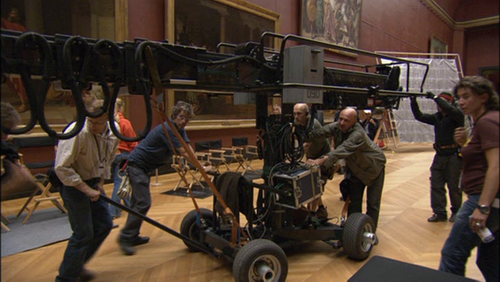
Filming The Da Vinci Code in the Louvre.
Kristin here—
In the 8th edition of Film Art: An Introduction, we added a feature, “Recommended DVD Supplements.” Most chapters end with one of these, which contains information about relevant supplements that might be useful to teachers and students. Filmgoers outside the classroom might find them helpful as well.
As we all know too well, many DVD supplements consist largely of interviews with the main cast and crew members in which they praise each other. (“I don’t know how we could have made this movie without _______. She was perfect for that part.” “We were lucky to be working with a director who’s a genius.”) Not very interesting. We try to sort through and find supplements where the filmmakers actually talk in an informative and entertaining way about how they went about their work.
Obviously many DVDs have come out since we finished our last round of revisions, so we plan to use this blog as a means of occasionally updating our recommendations. Your suggestions about especially informative supplements are welcome.
King Kong (Deluxe Extended Edition, Universal)
In Film Art 8, I recommended the Production Diaries Peter Jackson put together for King Kong, since they cover (albeit briefly) a lot of topics that few supplements tackle. One day’s diary entry is devoted entirely to clapperboards! In the extended King Kong DVD, some of the additional supplements also deal with topics that most DVD’s extras bypass.
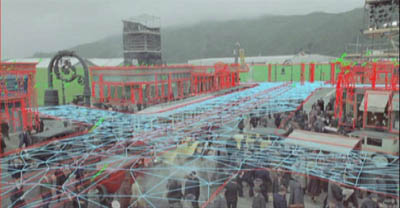
In relation to the section on settings in the Mise-en-scene chapter, for instance, you might look at “New York, New Zealand” (23 minutes). While most descriptions of CGI talk about how it is used to make monsters or crowds, this supplement discusses how the creation of settings can depend on digital imagery (above). During the fairly lengthy (42 minutes) documentary, “Pre-Production: The Return of Kong,” there is a discussion of what a First Assistant Director does during during this phase of production (40 minutes in). How often do you run across that? It could be used in conjunction with our layout of production roles in Chapter 1.
The 30-minute “Return to Skull Island” section goes into miniatures, matte paintings, and green-screen work—things that are often featured in supplements. This one also covers a less familiar technology, digital doubles.
Far from Heaven (Universal)
Supplements that examine a single scene, technique by technique, are pretty rare. One of the supplements on the Far from Heaven DVD does so in a useful way. The track originated as a documentary, “Anatomy of a Scene,” produced by the Sundance Channel (27 minutes). The analysis covers the production design and costumes, cinematography, acting, editing, and music. At the end, the completed scene is shown. The other large supplement on the disc, “The Making of Far from Heaven,” discusses the filmmakers’ attempts to replicate a 1950s look. It’s rather bland, with a little on style, a little on ideology, and a lot of mutual praise.
The Da Vinci Code (Sony; all editions have the supplements)
The DVD of The Da Vinci Code has two useful supplements. “Magical Places” (16 minutes) is an excellent demonstration on the logistics of going on location: permissions needed, technical challenges (such as lighting real interiors), and the substitution of one real building for another. Students will gain an awareness that even in real locales, filming doesn’t mean just going out, aiming a camera, and shooting stuff.
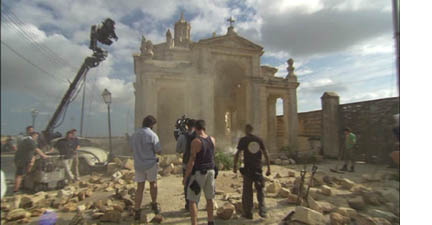
The second, “Filmmakers’ Journey Part One” (24.5 minutes) is not as good but still interesting. It could be used in conjunction with our Chapter 3, “Narrative as a Formal System,” which is rather hard to find relevant supplements for. There is discussion of character, timing, and rhythm. One passage that is particularly good for showing how filmmakers think about the form of films comes in a segment on the introduction of a major new character (Sir Lee Teabing) fully halfway through the film. Moreover, as director Ron Howard says, the Chateau Villette scene in question is a “high-wire act,” with a great deal of exposition suddenly brought into the middle of what has largely been an action-filled chase film. There is also discussion of the film’s series of journeys: “There was this sort of classic structure that we were working with.” It’s a pattern we discuss in Chapter 3. If nothing else, this supplement might convince students that their textbook’s authors are not just making up these terms to bedevil them!
Pirates of the Caribbean: Dead Man’s Chest ( Disney, 2-disc Special Edition)
Unexpectedly, one of the best sets of supplements I’ve seen lately accompanies Pirates of the Caribbean: Dead Man’s Chest. It’s a film that I mildly enjoyed watching, but I liked the making-of documentaries more. For one thing, the style is unusually low-key and lacks the chat about how wonderful everyone and everything was.
“Charting the Return” (about 26 minutes), for example, follows the stages of pre-production not just through interviews but also via a fly-on-the-wall presence of the camera at meetings and discussions. Often the people onscreen are not being interviewed but are actually at work, talking to each other. We see scripting, location scouting, design, and scheduling. Problems with deadlines and budgets are discussed rather than glossed over. The candor makes for a surprisingly entertaining and informative little movie. The same is true for “According to Plan” (60 minutes), which covers principal photography. Crew members delight in the beautiful Caribbean locales–but also complain about the heat, humidity, tides, rocking boats, and roads too small for equipment trucks. It’s one of the few accounts I’ve seen that suggests both the joys and the frustrations of real filmmaking.
Unless you’re really, really interested in costuming—or in ogling Jack Sparrow—the “Captain Jack: From Head to Toe” is frivolous. The “Mastering the Blade” segment can be skipped as well.
“Meet Davy Jones” (about 12 minutes) describes an important development in motion-capture technology for creating CGI characters. “Image-based motion capture” can extract mocap markers from a two-dimensional image (e.g., a shot of an actor performing on a stage) and make it three-dimensional. It can then be manipulated and placed back in the shot. In a discussion of modern special effects, this supplement might usefully be compared with the ones about the creation of Gollum in the Lord of the Rings: The Two Towers extended DVD set. The “Creating the Kraken” film (10 minutes) explains well how practical and CG special-effects are blended.
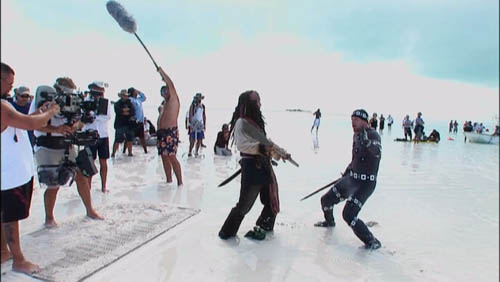
Filming as the tide covers the island used as a location.
You can skip the “Fly on the Set: The Bone Cage” segment, which is a skimpy four minutes on blue-screen special effects and the use of multiple cameras. OK, but this topic is covered more thoroughly on other films’ supplementary discs. Beware of “Jerry Bruckheimer: A Producer’s Photo Diary.” Bruckheimer makes up for all the compliments to director, cast and crew that were left out of the other supplements in this mercifully brief (5 minutes) track.
Unfortunately, some of the best recent films have come out on DVD with no supplements to speak of. When will we see some extras-laden editions of Cars and Zodiac?
[September 24: Film critic Kent Jones tells us that a deluxe DVD edition of Zodiac is coming out in the near future.]
I broke everything new again
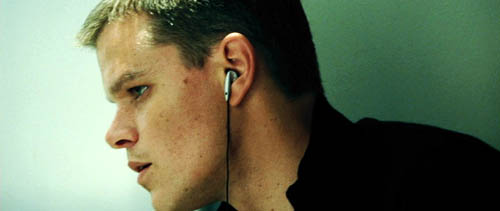
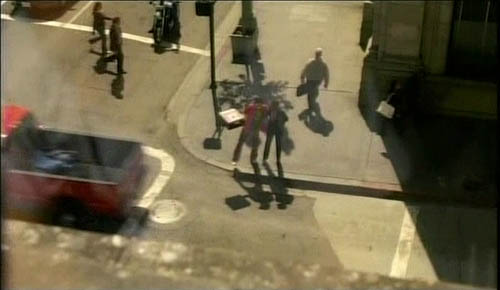
DB here:
Today some notes about cinematic storytelling in two trilogies, one long and one lasting only ninety seconds.
Extreme ways are back again
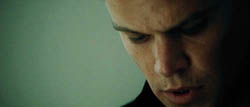
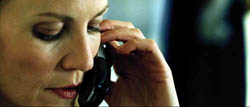
Yes, one more entry on The Bourne Ultimatum, which I thought I was done with. But alert reader Damian Arlyn sent me an email proposing an ingenious explanation for Ultimatum‘s repetition of a scene from The Bourne Supremacy. (Something like his idea is also suggested here and here.)
After yet another viewing, I agree: That scene is the same piece of plot action, replayed in a new context. This makes the film’s structure more interesting than I’d thought in my entries here and here.
Continue at the risk of spoilers.
At the climax of Supremacy, Jason kills Marie’s assassin in a traffic-clogged tunnel. He then visits the daughter of the Russian couple he murdered during his first CIA mission. The epilogue of Supremacy takes place in New York City. Jason calls Pamela Landy while he watches her in her office from an opposite building. Apparently as a token of thanks, Pam tells him his real name and adds his birthdate: “4/15/71.” Supremacy ends with him striding off with a shoulder bag and vanishing into the Manhattan crowd.
The phone conversation is replayed in Ultimatum. Bourne and Pam are in the same clothes, her office furniture is the same, what we hear of the dialogue is identical. But now the sinister Deputy Director Noah Vosen is monitoring the call, so at moments we see the scene refracted through his and his technicians’ eavesdropping. Just as important, Pam’s report of Jason’s birthdate turns out to be inaccurate. She has given him a coded reference: the building where he received his initiation into the assassin’s life is 415 71st Street. He heads there to confront Dr. Albert Hirsch, his Svengali. The script has played fair with us on this: We’ve had opportunities to glimpse Bourne’s real birthdate (9/13/70) on the paperwork Pam flicks through in an earlier scene.
You could argue that this replay dilutes the emotional force of the Supremacy scene. Instead of giving Jason back his identity, a gesture of emotional bonding, Pam presents yet another clue of the sort that has linked Bourne’s quest throughout the film. Feeling, one might say, has been replaced by espionage-movie plot mechanics. But I think that the device is more interesting than that. For one thing, if you’ve seen the first film, there will still be the lingering memory of your sense of Pam’s sincerity and Jason’s gratitude. Just as intriguing are the structural consequences.
If we imagine the second and third installments in the franchise as presenting one long story, the original phone conversation in Supremacy comes after most of the events we see in Ultimatum. Ultimatum begins with Bourne in Moscow, limping as he was upon leaving the daughter’s apartment and still spattered with blood from the tunnel chase. That is, the prologue of this film carries on continuously from the end of the second film’s climax, but long before its epilogue in New York.
After a title announcing, “Six Weeks Later,” Bourne’s European globetrotting in Ultimatum begins. Meanwhile, back at the CIA Pam explains that Jason had gone to Moscow to find the daughter. The bulk of the film carries him to Paris, London, Madrid, and Tangier, all the while trailed by the agency. The final clue brings Bourne to Manhattan. Only then does he visit the building opposite the CIA station and make the call we’ve already, and incompletely, seen at the close of the second film. This new version of the scene initiates the final section of Supremacy, as Bourne sends the agents on a false trail, breaks into Noah’s office to grab incriminating documents (which he tucks into that shoulder bag), and makes his way to 71st Street and his fateful confrontation with Hirsch.
So the two films mesh intriguingly. Most of film 3 takes place just before the end of film 2, making the epilogue of 2 launch the climax of 3. This is a step beyond the more common sort of flashback to founding events in the story chronology, the tactic used at the start of Indiana Jones and the Last Crusade and The Lord of the Rings: The Return of the King. In these films, the jump back in time is more obviously signposted than in the Bourne movies.
The screenwriters Tony Gilroy, Scott Z. Burns, George Nolfi, and Tom Stoppard (uncredited) have made a clever and welcome innovation that I didn’t appreciate at first. I’m happy to finally understand it, though, because it fits into a trend I discussed in The Way Hollywood Tells It and an earlier entry. Some filmmakers today create looping, back-and-fill story lines that tease us into watching the movie over and over on DVD, à la Memento and Donnie Darko. There are still some Bourne questions lingering in my mind, so I guess Universal can sign me up as a DVD customer. . . sigh.
I’ve seen so much in so many places
Speaking of The Way, there I also noted the growth in contemporary cinema of what I call network narratives, or what Variety calls criss-crossers. These are films with several protagonists connected by friendship, kinship, or accident. The characters pursue different goals but as the film develops their actions affect one another. The classic examples are Nashville, Short Cuts, and Magnolia, but in writing about this strategy for my collection Poetics of Cinema, I found over a hundred such movies.
This week I noticed that a trio of TV commercials from Liberty Mutual Insurance seems to be influenced by this format. Each of these “Responsibility” ads compresses network principles into thirty seconds, while also adding a Twilight-Zoneish time warp. You can watch the ads here.
Each commercial begins by showing a woman and a pizza-delivery kid at a street corner. She thrusts out her arm to keep him from striding into the path of a car.
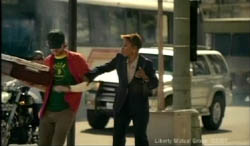
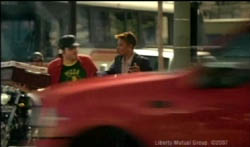
Somebody sees the woman’s act of kindness, and then that person is shown doing something kind. Someone else sees the second person and then is shown being kind, and so on. For example, in one variant a man across the street notices the woman and the delivery boy, and then he helps a lady with a baby get off a bus. He is watched by a man at the bus stop, who then is shown helping someone else. Like a benign contagion, solicitude spreads from person to person.
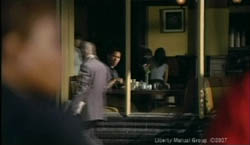
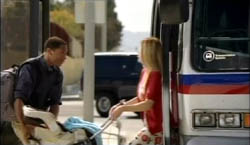
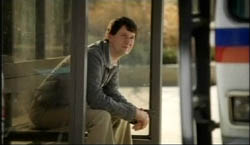
So we have a very slight set of connections: A is seen by B who is seen by C and so on. This patterning seems comparable to the shifting plotlines and viewpoints we find in some network films, with each character connected by accident and spatial proximity. The framings orient us by overlapping bits of space; the pizza boy’s red jacket gives us a landmark in the foreground, as does the bus in the later shot.
More interestingly, all three ads start with the same situation, the woman and the pizza boy, but they move on to different B’s, C’s, etc. In the variant I just mentioned, the man watching is sitting across the street. In another one, the woman’s act of responsibility is observed by the biker behind her, and he becomes B in a new chain of connections, setting out a traffic cone to warn drivers.
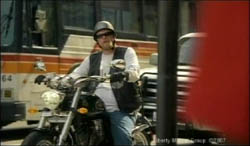
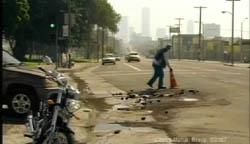
The biker is visible in the first shot of the other ads (see above), but there he plays no role. In the third ad, a man watching from above sees the pizza-boy mishap. (His point-of-view shot is at the top of this post.)
So, as with Jason’s and Pam’s conversation in Bourne, we have a narrative node or pivot that is contextualized differently in another film. What allows this to work, I suggest, is a piece of our social intelligence–our understanding that chance can connect people—plus our cultural experience with storytelling, particularly network narratives. The oddest twist, though, comes at the end of each ad, which like the Bourne trilogy offers an interesting repetition.
Each string of actions ends with the woman we saw at the beginning observing someone else’s act of kindness. For example, in one ad she sees a man at an airport baggage conveyor help an old man snag his bag.
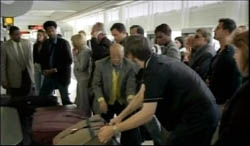
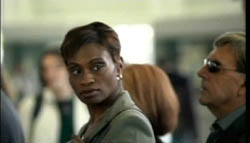
And then once more we see her halt the pizza-delivery kid. So each ad gives us a network something like this: A-B-C-D-…-A. The action moves in a circle, back to the woman as a witness, and then back to her at the pedestrian crossing, once more protecting the delivery boy.
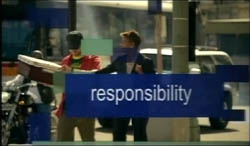
Huh? The ending of the ad suggests that by seeing another person acting responsibly, the woman is more inclined to warn the boy. But that act, with the same boy, was what set off the chain of charity in the first place. In strictly realistic terms, we’ve got a sort of möbius strip (no, not a Moby strip), where the head is glued to the tail and the whole cycle is in a twist.
Well, consider the filmmakers’ problem. How could you end it otherwise? The cascade of charity could go on indefinitely, which is not a plausible scenario for a thirty-second spot. Instead, the swallowing-the-tail tactic brings the pattern to a satisfying conclusion, while providing an event that can be the jumping-off point for another cycle in another ad. The last shot of any of the ads is the first shot of any of the others. You can enjoy the whole cycle as a mini-movie that jumps back in time to the original act of kindness at the corner.
Of course the pattern isn’t meant to be realistic. The message is that small acts can make a difference, and that Liberty Mutual tries to live up to an ideal of responsibility in its business. The themes are presented in an oblique, rather poetic story that suggests that kindness is catching and that even as strangers we are bound to help one another. Significantly, the act that’s presented through multiple replays is the most consequential: the woman is in effect saving the pizza boy’s life.
Both the Bourne movies and “Responsibility” show that studying film narrative is endlessly interesting, and storytellers can be quite creative. There’s always room in life for this.
Is there a blog in this class?
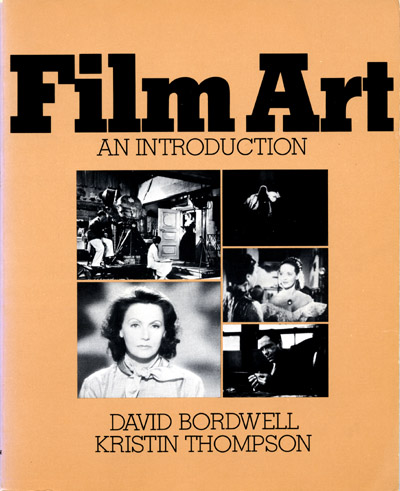
First edition, Addison-Wesley, 1979
Kristin here–
As our blog’s name suggests, we started it partly so we could write about subjects that would be of interest to lovers of cinema. It’s also a resource upon which teachers, students, and general readers using our textbook, Film Art: An Introduction, can draw. For that matter, many entries contain material that is pertinent to Film History: An Introduction as well. The entries are written in a more informal fashion than are the textbooks, but they often extend or elaborate points made in the books.
Now that universities here in the U.S. and in many other countries are beginning their autumn semesters, it seemed a good time for us to suggest some possibilities for using specific blog entries to cast light on topics in our text.
Second edition, Random House, 1986
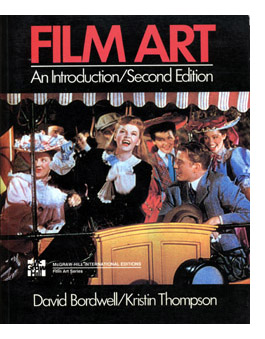 First, there are some general entries that might aid the teacher as courses begin. For those who show excerpts from DVDs in classes and are nervous about copyright issues, my piece, “Film educators no longer criminals” will be reassuring. It explains how last year fair-use exemptions covering just that situation were put into effect last year. Create that Powerpoint lecture or bring a DVD into class to analyze with impunity.
First, there are some general entries that might aid the teacher as courses begin. For those who show excerpts from DVDs in classes and are nervous about copyright issues, my piece, “Film educators no longer criminals” will be reassuring. It explains how last year fair-use exemptions covering just that situation were put into effect last year. Create that Powerpoint lecture or bring a DVD into class to analyze with impunity.
Teachers often confront the problem of overcoming students’ resistance to subtitled, black-and-white, and/or silent films. My entry “Subtitles 101” might be of some help in persuading them to be more open to viewing unfamiliar kinds of films. David’s “From Hollywood to Atlanta to us,” on the huge variety of films to be found on Turner Classic Movies, suggests the delights of having access to such a wide range of cinema history. (Also check out Jim Emerson’s recent “Gimme them old-time furrin pictures” on his Scanners blog.)
For students who don’t see a difference between watching films on an iPod and a cinema screen, David ruminates on some of the advantages and disadvantages of the tiny digital image in “Area man lives in fear that attractive woman will ask what’s on his iPod.” Similarly, for those who confidently expect to be able to find anything they need for viewing or researching term papers online, my “The Celestial Multiplex” might prove an eye-opener.
Third edition, McGraw-Hill, 1990
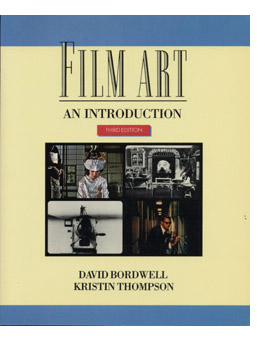 Chapter 1 begins by briefly introducing film as an art form. David’s entry, “But what kind of art?” could be used to fill out that section, though it is most appropriate for film majors and advanced classes.
Chapter 1 begins by briefly introducing film as an art form. David’s entry, “But what kind of art?” could be used to fill out that section, though it is most appropriate for film majors and advanced classes.
The chapter also differentiated between studio and independent filmmaking. David’s “Independent film: how different?” is relevant here. For a discussion of the auteur theory as contested by one prominent Hollywood writer, Joe Eszterhas, see David’s “Who the devil wrote it? (apologies to Peter Bogdanovich).”
These days news sources cover the weekend box-office figures and rank the highest grossing films. The raw figures don’t tell the whole story, though, since they don’t specify how many theaters each title is showing in or how big each film’s production budget was. A film playing in only a few theaters might be low on a list, but if it is making thousands of dollars more per theater, it might ultimately be more successful. A low-budget film doesn’t need to gross as much to become profitable as a costly epic does. My “What won the weekend, or, How to understand box-office figures” adds some nuances to the simple lists reporters give us each Monday.
Chapter 2 includes a section on “Formal Expectations.” One of the effects of creating expectations can be suspense. In “This is your brain on movies, maybe,” David explores why viewers enjoy watching films where they know the outcome, either through having seen the film before or because the story is based on real events—in this case United 93.
Chapter 3 is devoted to cinematic storytelling. A sample analysis of narrative organization can be found outside the blog, in David’s online essay on Mission: Impossible III. On our very first blog entry, back in September 2006, we quoted the director of One Hour Photo explaining how he rethought the film’s original plot structure so as to maximize curiosity. In the same chapter, we include “Openings, Closings, and Patterns of Development” as one of the principles of narrative construction. David’s blog entry “First shots” discusses some of the ways filmmakers have historically used first shots to plant narrative information, introduce motifs, establish tone, and, in recent decades, to lead off with a dense, virtuoso moment to be savored as such.
Fourth edition, McGraw-Hill, 1993
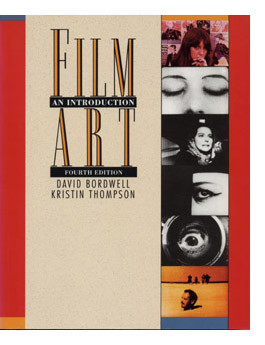 Recent years have seen sequels, prequels, series, and other forms of extended narratives being used more pervasively in Hollywood cinema. My “Originality and origin stories” discusses the phenomenon of the film that jumps back to an early stage in the life of a character in a previous film. David explores two other current trends, toward narratives involving networks of criss-crossing characters and those that play self-consciously with plot, in “An appetite for artifice.”
Recent years have seen sequels, prequels, series, and other forms of extended narratives being used more pervasively in Hollywood cinema. My “Originality and origin stories” discusses the phenomenon of the film that jumps back to an early stage in the life of a character in a previous film. David explores two other current trends, toward narratives involving networks of criss-crossing characters and those that play self-consciously with plot, in “An appetite for artifice.”
Does the increasing consumption of films on DVDs rather than in theaters change the way we watch and understand narratives? Does the remote control encourage us to manipulate what we’re seeing in ways unexpected by the filmmakers? David tackles that question in “New media and old storytelling.”
One of the most popular topics covered in Chapter 4, on Mise en scene, is acting. In “Good actors spell good acting,” I consider how a focus on an impressive performance can sometimes lead a critic to downplay other aspect of a films. An older tradition of ensemble performance in relation to camera position gets some analysis in “Watching movies very, very slowly.”
David’s fascination with modern styles of cinematography (Chapter 5) and editing (Chapter 6) is evident in several entries, most illustrated with many frame enlargements. In “Can they make ‘em like they used to? continued,” he deals with foreground objects and depth of focus. His essay on “Shot-consciousness” examines a specific type of framing that places the characters against a flat background and frontally facing the camera—a technique he terms “planimetric framing.”
In another entry on cinematography, “Funny framings,” David explores how the manner in which the camera frames its subject can create humor. This has been one of our most popular entries, as is evidenced by the number of people who wrote to David with their favorite examples. In “Walk the talk,” David discusses the specific sort of tracking shot that follows characters talking with each other.
Occasionally our blog gets caught up in a topic that has generated controversy among critics. One of these is the use of fast cutting and abnormally fast, out-of-focus camera movements in The Bourne Ultimatum. Nausea-inducing excess or deliberately disorienting style? In two entries, David argues that the hyperactive camera is largely unmotivated and distracting: “Unsteadicam chronicles” and “[insert your favorite Bourne pun here].”
One of our first entries to gain widespread attention was David’s discussion of story structure and editing in “The Departed: no departure.” He discussed the increasing rapidity of Scorsese’s cutting and linked it to a broader trend of intensified continuity in American cinema. That trend is explained further in “Intensified continuity revisited.” In the case of The Good German, a film that claimed to mimic classical Hollywood films of the 1940s and 1950s, David discussed the concept of “coverage” in traditional filming. See his “Cutting remarks on THE GOOD GERMAN, classical style, and the Police Tactical Unit.”
Fifth edition, McGraw-Hill, 1997
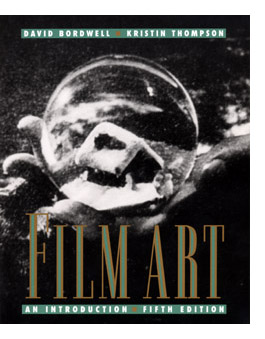 In teaching non-classical approaches to film editing, David’s “Another pebble in your shoe” might be useful. There David discusses how Lars von Trier used multiple cameras to film scenes and a computer to dictate seemingly random cutting in The Boss of It All.
In teaching non-classical approaches to film editing, David’s “Another pebble in your shoe” might be useful. There David discusses how Lars von Trier used multiple cameras to film scenes and a computer to dictate seemingly random cutting in The Boss of It All.
Chapter 6 includes a section on “Rhythmic Relations Between Shot A and Shot B.” There we discuss the number of frames in each shot as a measure of screen duration. David talks about counting frames in film vs. various video formats in “My name is David and I’m a frame-counter.”
In our extended analysis of continuity editing in the opening scene of The Maltese Falcon, we discuss the technique of shot/reverse shot—the basic editing pattern used in conversation scenes in classical films. “Angles and perceptions” discusses this technique and what happens when a scene holds on a shot of one speaker without cutting to the reverse shot. Late in “Walk the Talk,” there’s an analysis of how continuity editing can be coordinated with staging and framing.
When watching a film, we seldom perceive the sound tracks as a blend of many separate recordings. It comes across as a seamless sonic accompaniment to the images. David had the opportunity to sit in on a sound-mixing session for the new film 3:10 to Yuma, directed by James Mangold. He describes that experience in “Christian Bale picks up a rail.” (This could provide an additional example for the section of Chapter 7 entitled, “Selection, Alteration, and Combination,” pp. 268-272.)
In Chapter 8 of Film Art we use Citizen Kane as our summary instance of film style. Some blog entries that deal with style in specific films include: “TANGO marathon” (on Béla Tarr’s epic Sátántangó); “Not back to the future, but ahead to the past” (on Steven Soderbergh’s attempt to mimic 1940s Hollywood style in The Good German); and “Classical cinema lives! New evidence for old norms” (on computer-generated special effects and their narrative functions).
Sixth edition, McGraw-Hill, 2001
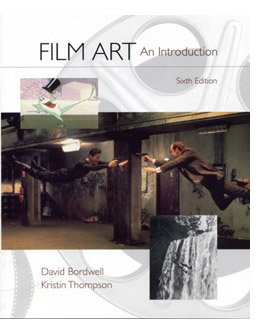 In Chapter 9, we deal with film genres. In “Swords vs. lightsabers,” I talk about the cyclical nature of genres, suggesting that science-fiction films are waning in popularity just as fantasy films are becoming popular.
In Chapter 9, we deal with film genres. In “Swords vs. lightsabers,” I talk about the cyclical nature of genres, suggesting that science-fiction films are waning in popularity just as fantasy films are becoming popular.
Chapter 10 examines documentary, experimental, and animated films. Pixar is currently at the forefront of Hollywood animation. I’ve written on Cars in “Reflections on cars,” and David and I have a dialogue on Ratatouille in “Rat rapture.” In “By Annie standards,” I discuss why recent animated films are often better than live-action ones. David offers an appreciation of Disney’s classic features in “Uncle Walt the artist.”
We dicuss experimental filmmakers in “Lewis Klahr, X 3, X 4” (David), “3 notions about CREMASTER 2” (David on Matthew Barney’s cycle of films), and “Len Lye, renaissance Kiwi” (me on New Zealand’s great creator of experimental animation).
Chapter 11 ends with a section on “Writing a Critical Analysis of a Film.” David’s entry, “Watching movies very, very slowly,” gives a vivid demonstration of how we go about the research that goes into a detailed film analysis.
Some of our blog entries could be read in relation to more than one chapter. David’s “Charlie, meet Kentaro,” on the Charlie Chan and Mr. Moto B-film series, deals with film history, style, and ideology.
Seventh edition, McGraw-Hill, 2004
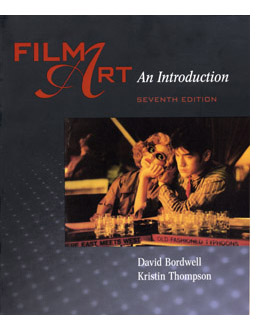 For musings on the relationship of early cinema to Victorian painting, see David’s “Professor sees more parallels between things, other things.”
For musings on the relationship of early cinema to Victorian painting, see David’s “Professor sees more parallels between things, other things.”
David’s book, Ozu and the Poetics of Cinema, is now available online. For details, see his “I wrote a book, but …; or, what did the professor forget?”
Some teachers dealing with the classical Hollywood cinema of the 1930s to 1950s may wish to cover the B movie. Grad students and alumni of the University of Wisconsin film-studies program contribute to a dialogue on the subject in “Bs in their bonnets: A three-day conversation well worth the reading.”
We deal with the important institution of film festivals. I review a book on one of the most important of these festivals in “Cannes: Beyond the art, hype, and politics.”
When the second edition of Film History came out, two of the auteurs whose careers we examine in Chapter 19 were still alive. Now Ingmar Bergman and Michelangelo Antonioni have both died, and on the same day. David’s “Bergman, Antonioni, and the stubborn style” could make a coda for our chapter sections on those directors.
For updated information on Asian cinema, check the tags on the right. For recent Danish cinema, see David’s, “My Danish December.”
At intervals we report from film festivals we attend. So far such reports have come from the 2006 Vancouver Film Festival, the 2007 Hong Kong Film Festival, Roger Ebert’s Overlooked Film Festival (aka “Ebertfest,” 2007), and Il Cinema Ritrovato (“Rediscovered cinema,” in Bologna, Italy, 2007). These reports deal with the people we meet there, the films we see, and the institutions that run the festivals. We’ll continue to write such dispatches during our travels. Most of these reports have multiple parts, so be sure to follow the links.
As I said at the outset, our blog can serve as a supplement to our textbooks. We usually don’t, however, write new entries with that in mind. As we see recent films, revisit old ones, read books, and see information posted on the internet, we find inspiration to engage with the cinema in fresh ways. We find ourselves making contact with people we had never met and reconnecting with colleagues we have not heard from in decades. We hope that we are learning as we go along and passing along some of that learning to readers of Film Art and Film History.
Note: Elsewhere on this website there is a section on Film Art. Here you can find a list of corrections for errata in the 8th edition. We also include all of the sample analyses that have been cut from various editions: The Man Who Knew Too Much, Stagecoach, Hannah and Her Sisters, Desperately Seeking Susan, Day of Wrath, Last Year at Marienbad, Innocence Unprotected, Clock Clearners, Tout va bien, High School.
[November 15, 2009: See also the 2008 and 2009 updates on more recent blog entries.]
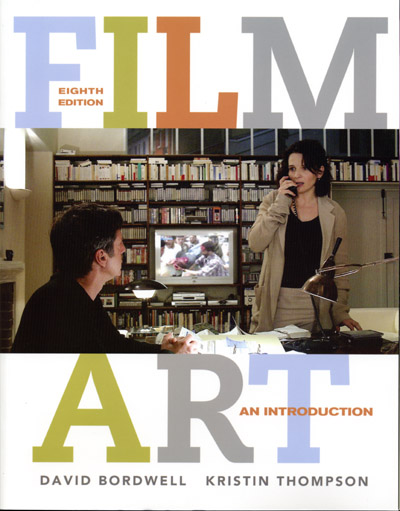
Eighth edition, McGraw-Hill, 2008
Legacies
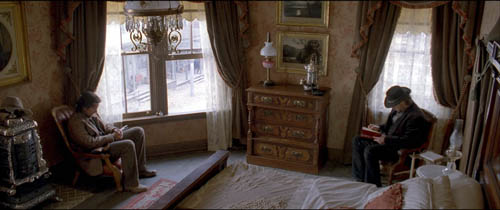
DB here:
By now James Mangold’s 3:10 to Yuma has had its critics’ screenings and sneak previews. It’s due to open this weekend. The reviews are already in, and they’re very admiring.
Back in June, I saw an early version as a guest of the filmmaker and I visited a mixing session, which I chronicled in another entry. I was reluctant to write about the film in the sort of detail I like, because I wasn’t seeing the absolutely final version and because it would involve giving away a lot of the plot.
I still won’t offer you an orthodox review of the film, which I look forward to seeing this weekend in its final theatrical form. Instead, I’ll use the film’s release as an occasion to reflect on Mangold’s work, on his approach to filmmaking, and on some general issues about contemporary Hollywood.
An intimidating legacy
It seems to me that one problem facing contemporary American filmmakers is their overwhelming awareness of the legacy of the classic studio era. They suffer from belatedness. In The Way Hollywood Tells It, I argue that this is a relatively recent development, and it offers an important clue to why today’s ambitious US cinema looks and sounds as it does.
In the classic years, there was asymmetrical information among film professionals. Filmmakers outside the US were very aware of Hollywood cinema because of the industry’s global reach. French and German filmmakers could easily watch what American cinema was up to. Soviet filmmakers studied Hollywood imports, as did Japanese directors and screenwriters. Ozu knew the work of Chaplin, Lubitsch, and Lloyd, and he greatly admired John Ford. But US filmmakers were largely ignorant of or indifferent to foreign cinemas. True, a handful of influential films like Variety (1925) and Potemkin (1925) made an impact on Hollywood, but with the coming of sound and World War II, Hollywood filmmakers were cut off from foreign influences almost completely. I doubt that Lubitsch or Ford ever heard of Ozu.
Moreover, US directors didn’t have access to their own tradition. Before television and video, it was very difficult to see old American films anywhere. A few revival houses might play older titles, but even the Museum of Modern Art didn’t afford aspiring film directors a chance to immerse themselves in the Hollywood tradition. Orson Welles was considered unusual when he prepared for Citizen Kane by studying Stagecoach. Did Ford or Curtiz or Minnelli even rewatch their own films?
With no broad or consistent access to their own film heritage, American directors from the 1920s to the 1960s relied on their ingrained craft habits. What they took from others was so thoroughly assimilated, so deep in their bones, that it posed no problems of rivalry or influence. The homage or pastiche was largely unknown. It took a rare director like Preston Sturges to pay somewhat caustic respects to Hollywood’s past by casting Harold Lloyd in Mad Wednesday (1947), which begins with a clip from The Freshman. (So Soderbergh’s use of Poor Cow in The Limey has at least one predecessor.)
Things changed for directors who grew up in the 1950s and 1960s. Studios sold their back libraries to TV, and so from 1954 on, you could see classics in syndication and network broadcast. New Yorkers could steep themselves in classic films on WOR’s Million-Dollar Movie, which sometimes ran the same title five nights in a row. There were also campus film societies and in the major cities a few repertory cinemas. The Scorsese generation grew up feeding at this banquet table of classic cinema.
In the following years, cable television, videocassettes, and eventually DVDs made even more of the American cinema’s heritage easily available. We take it for granted that we can sit down and gorge ourselves on Astaire-Rogers musicals or B-horror movies whenever we want. Granted, significant areas of film history are still terra incognita, and silent cinema, documentary, and the avant-garde are poorly served on home video. Nonetheless, we can explore Hollywood’s genres, styles, periods, and filmmakers’ work more thoroughly than ever before. Since the 1970s, the young American filmmaker faces a new sort of challenge: Now fully aware of a great tradition, how can one keep from being awed and paralyzed by it? How can a filmmaker do something original?
I don’t suggest that filmmakers have decided their course with cold calculation. More likely, their temperaments and circumstances will spontaneously push them in several different directions. Some directors, notably Peckinpah and Altman, tried to criticize the Hollywood tradition. Most tried simply to sustain it, playing by the rules but updating the look and feel to contemporary tastes. This is what we find in today’s romantic comedy, teenage comedy, horror film, action picture, and other programmers.
More ambitious filmmakers have tried to extend and deepen the tradition. The chief example I offer in The Way is Cameron Crowe’s Jerry Maguire, but this strategy also informs The Godfather, American Graffiti, Jaws, and many other movies we value. I also think that new story formats like network narratives and richly-realized story worlds have become creative extensions of the possibilities latent in classical filmmaking.
James Mangold’s career, from Heavy onward, follows this option, though with little fanfare. He avoids knowingness. He doesn’t fill his movies with in-jokes, citations, or homages. Instead, he shows the continuity between one vein of classical cinema and one strength of indie film by concentrating on character development and nuances of performance. In an industry that demands one-liners and catch-phrases sprinkled through a script, Mangold offers the mature appeal of writing grounded in psychological revelation. In a cinema that valorizes the one-sheet and special effects and directorial flourishes, he begins by collaborating with his actors. He is, we might say, following in the steps of Elia Kazan and George Cukor.
Sandy
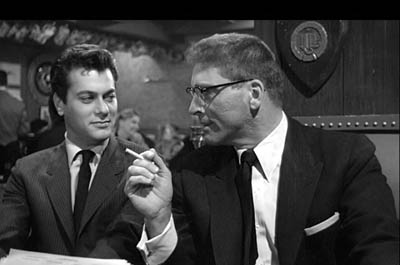
By his own account, Mangold awakened to these strengths during his formative years at Cal Arts, where he studied with Alexander Mackendrick. Mackendrick directed some of the best British films of the 1940s and 1950s, but today he is best known for Sweet Smell of Success.
Seeing it again, I was struck by the ways that it looks toward today’s independent cinema. It offers a stinging portrait of what we’d now call infotainment, showing how a venal publicist curries favor with a monstrously powerful gossip columnist. It’s not hard to recognize a Broadway version of our own mediascape, in which Larry King, Oprah, and tmz.com anoint celebrities and publicists besiege them for airtime. While at times the dialogue gets a little didactic (Clifford Odets did the screenplay), the plotting is superb. Across a night, a day, and another night, intricate schemes of humiliation and aggression play out in machine-gun talk and dizzying mind games. It’s like a Ben Jonson play updated to Times Square, where greed and malice have swollen to grandiose proportions, and shysters run their spite and bravado on sheer cutthroat adrenalin.
Sweet Smell was shot in Manhattan, and James Wong Howe innovated with his voluptuous location cinematography. “I love this dirty city,” one character says, and Wong Howe makes us love it too, especially at night.
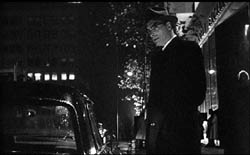
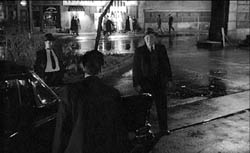
Today major stars use indie projects to break with their official personas, and the same thing happens in Mackendrick’s film. Burt Lancaster, who had played flawed but honorable heroes, portrayed the columnist J. J. Hunsecker with savage relish. “My right hand hasn’t seen my left hand in thirty years,” he remarks. Tony Curtis, who would go on to become a fine light comedian, plays Sidney Falco as a baby-faced predator, what Hunsecker calls “a cookie full of arsenic.” Falco is sunk in petty corruption, ready to trade his girlfriend’s sexual favors for a notice in a hack’s column. Hunsecker and Falco, host and parasite, dominator and instrument, are inherently at odds, then in a breathtaking scene they double-team to break the will of a decent young couple. There are no heroes. Nor, as Mangold points out in his Afterword to the published screenplay, do we find any of that “redemption” that today’s producers demand in order to brighten a bleak story line.
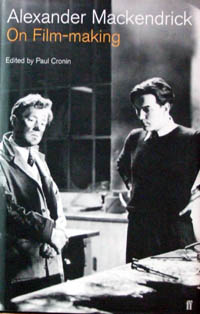 Mackendrick must have been a wonderful teacher. On Film-Making, Paul Cronin’s published collection of his course notes, sketches, and handouts, forms one of our finest records of a director’s conception of his art and craft. Offering a sharp idea on every page, the book should sit on the same shelf with Nizhny’s Lessons with Eisenstein.
Mackendrick must have been a wonderful teacher. On Film-Making, Paul Cronin’s published collection of his course notes, sketches, and handouts, forms one of our finest records of a director’s conception of his art and craft. Offering a sharp idea on every page, the book should sit on the same shelf with Nizhny’s Lessons with Eisenstein.
Mangold became a willing apprentice to Mackendrick. “He taught me more craft than I could articulate, but beyond that, he showed me how hard one had to work to make even a decent film.” (1) Mangold’s afterword to the Sweet Smell screenplay offers a precise dissection of the first twenty minutes. He shows how the script and Mackendrick’s direction prepare us for Hunsecker’s entrance with the utmost economy. Mangold traces out how five of Mackendrick’s dramaturgical rules, such as “A character who is intelligent and dramatically interesting THINKS AHEAD,” are obeyed in the film’s first few minutes. The result is a taut character-driven drama, operating securely within Hollywood construction while opening up a sewer in a very un-Hollywood way. Surely Sandy Mackendrick’s boldness helped Mangold find his own way among the choices available to his generation.
Movies for grownups
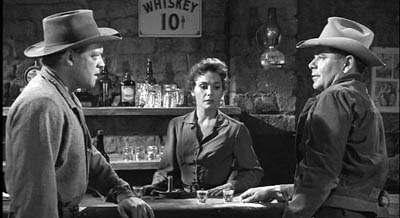
Mangold has often mentioned his love for classic Westerns; on the DVD commentary for Cop Land he admits that he wanted it to blend the western with the modern crime film. But why Delmer Daves’ 3:10 to Yuma?
The Searchers, Rio Bravo, and The Man Who Shot Liberty Valance were objects of veneration for directors of the Bogdanovich/ Scorsese/ Walter Hill generation, while Yuma seemed to be a more run-of-the-mill programmer. To American critics in the grips of the auteur theory, Delmer Daves sat low in the canon, and Glenn Ford and Van Heflin offered little of the star wattage yielded by John Wayne, James Stewart, and Dean Martin. In retrospect, though, I think that you can see what led Mangold to admire the movie.
For one thing, it’s a close-quarters personal drama. It doesn’t try for the mythic resonance of Shane or The Searchers or Liberty Valance, and it doesn’t relax into male camaraderie as Rio Bravo does. The early Yuma simply pits two sharply different men against one another. Ben Wade is a robber and killer who is so self-assured that he can afford to be courteous and gentle on nearly every occasion. Dan Evans is a farmer so beaten down by bad weather, bad luck, and loss of faith in himself that he takes the job of escorting the killer to the train depot.
That dark glower that made Glenn Ford perfect for Gilda and The Big Heat slips easily into the soft-spoken arrogance of Wade. His self-assurance makes it easy for him to play on all of Evans’ doubts and anxieties. In counterpoint, Van Heflin gives us a man wracked by inadequacy and desperation; his flashes of aggression only betray his fears. In the end, his courage is born not of self-confidence but of sheer doggedness and a dose of aggrieved envy. He has taken a job, he needs the money to provide for his family, and, at bottom, it’s not right that a man like Wade should flourish while Evans and his kind scrape by. As in Sweet Smell of Success, the drama is chiefly psychological rather than physical, and the protagonist is far from perfect.
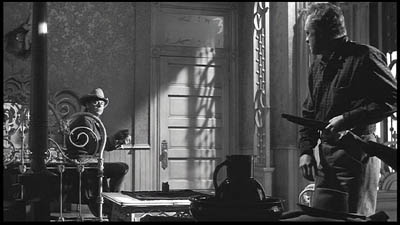
Daves shows the struggle without cinematic flourishes, in staging and shooting as terse as the prose in Elmore Leonard’s original story. Deep-focus images and dynamic compositions maintain psychological pressure, and as ever in Hollywood films, undercurrents are traced in postures and looks, as when Wade in effect takes over Evans’ role as father at the dinner table.
One more factor, a more subliminal one, may have attracted Mangold to Daves’ western. 3:10 to Yuma was released in 1957, about two months after Sweet Smell of Success. Both belong to a broader trend toward self-consciously mature drama in American movies. Faced with dwindling audiences, more filmmakers were taking chances, embracing independent and/or East Coast production, and offering an alternative to teenpix and all-family fare. 1957 is the year of Bachelor Party, Twelve Angry Men, Edge of the City, A Face in the Crowd, The Garment Jungle, A Hatful of Rain, The Joker Is Wild, Mister Cory (also with Tony Curtis), No Down Payment, Pal Joey, Paths of Glory, Peyton Place, Run of the Arrow, The Strange One, The Tarnished Angels, The Three Faces of Eve, Twelve Angry Men, and The Wayward Bus. These films and others featured loose women, heroes who are heels, and “adult themes” like racial prejudice, rape, drug addiction, prostitution, militarism, political corruption, suburban anomie, and media hucksterism. (Who says the 1950s were an era of cozy Republican values and Leave It to Beaver morality?) Today many of these films look strained and overbearing, but they created a climate that could accept the doggedly unheroic Evans and the proudly antiheroic Sidney Falco.
3:10 x 2
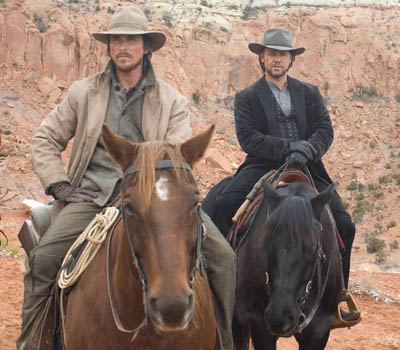
Mangold’s remake is a re-imagining of Daves’ film, more raw and unsparing. Both films give us the journey to town and a period of waiting in a hotel room. In the original, Daves treats the sequences in the hotel room as a chamber play. Each of Wade’s feints and thrusts gets a rise out of Evans until they’re finally forced onto the street to meet Wade’s gang and the train. Mangold has instead expanded the journey to the railway station, fleshing out the characters (especially Wade’s psychotic sidekick) and introducing new ones. This leaves less space for the hotel room scenes, which are I think the heart of Daves’ film.
At the level of imagery, the new version is firmly contemporary. The west is granitic; men are grizzled and weatherbeaten. When Wade and Evans get into the hotel room, Daves’ low-angle deep-focus compositions are replaced by the sort of brief singles that are common today. As in all Mangold’s work, minute shifts in eye behavior deepen the implications of the dialogue.
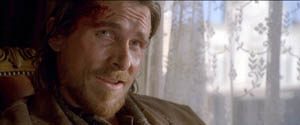
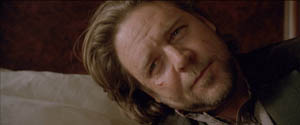
Similarly, the cutting, the speediest of any Mangold film, is in tune with contemporary pacing. At an average of 3 seconds per shot, it moves at twice the tempo of Daves’ original. Mangold has been reluctant to define himself by a self-conscious pictorial style. “I think writer-directors have less of a need sometimes to put a kind of obvious visual signature over and over again on their movies . . . . I don’t need to go through this kind of conscious effort to become the director who only uses 500mm lenses.” (2)
Mangold puts his trust in well-carpentered drama and nuanced performances. Daves begins his Yuma with Wade’s holdup of a stage, linking his movie to hallowed Western conventions, but Mangold anchors his drama in the family. His film begins and ends with Evans’ son Bill, who’s first shown reading a dime novel. We soon see his father, already tense and hollowed-out. At the end Mangold gives us a resolution that is more plausible than that of Leonard’s original or Daves’ version. What the new version loses by letting Evans’ wife Alice drop out of the plot it gains by shifting the dramatic weight to Bill in the final moments. The conclusion is drastically altered from the original, and it shocked me. But given Mangold’s admiration for the shadowlands of Sweet Smell, it makes sense.
In an interview Mangold remarks that Mackendrick distrusted film school because it stressed camera technique and didn’t prepare directors to work with actors. “It’s a giant distraction in film schools that in a way, by avoiding the world of the actor, young filmmakers are avoiding the most central relationship of their lives in the workplace.” (3) As we’d expect from Mangold’s other films, the central performances teem with details. Bale cuts up Crowe’s beefsteak, and Crowe gestures delicately with his manacles when he softly demands that the fat be trimmed. Bale’s gaunt, limping Evans, a Civil War casualty, becomes an almost spectral presence; his burning glances reveal a man oddly propelled into bravery by his failures. Crowe’s Ben Wade, for all his intelligence and jauntiness, is oddly unnerved by this farmer’s haunted demeanor. Actors and students of performance will be kept busy for years studying the two films and the way they illustrate different conceptions of the characters and the changes within mainstream cinema.
Sometimes I think that Hollywood’s motto is Tell simple stories with complex emotions. The classic studio tradition found elemental situations and used film technique and great performers to make sure that the plot was always clear. Yet this simplicity harbored a turbulent mixture of contrasting feelings, different registers and resonances, motifs invested with associations, sudden shifts between sentiment and humor. In his commitment to vivid storytelling and psychological nuances, Mangold has found a vigorous way to keep this tradition alive. Sandy would have been proud.
(1) James Mangold, “Afterword,” Clifford Odets and Ernest Lehman, Sweet Smell of Success (London: Faber, 1998), 165.
(2) Quoted in Stephan Littger, The Director’s Cut: Picturing Hollywood in the 21st Century (New York: Continuum, 2006), 317.
(3) Quoted in Littger, 313.
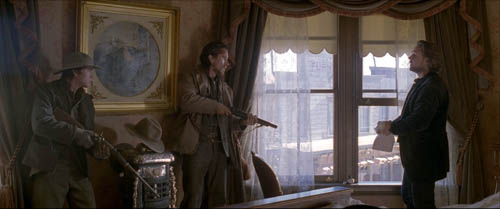
PS 9 Sept: Susan King’s article in the Los Angeles Times explains that Mangold first got acquainted with Daves’ film in Mackendrick’s class. “We would break down the dramatic structure of the film. This one really got under my skin, partly because it always really moved me. It also felt original in scope in that it was very claustrophobic and character-based.” King’s article gives valuable background on the difficulties of getting the film produced.













